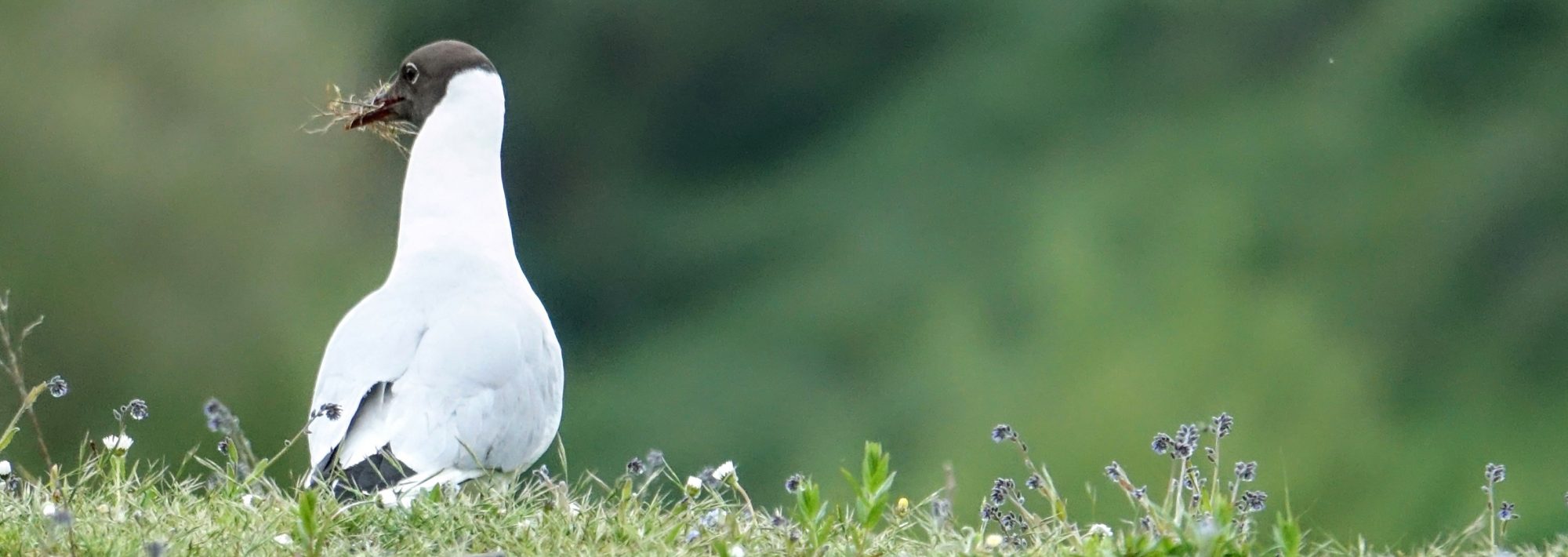Field Trip Meeting – WWT Martinmere – Sunday, 10th December 2023 – report by Sue Brealey
A group of 38 participants for this trip gathered at the Shirehall, prior to a coach journey to WWT Martinmere, leaving at 8.15am. The journey was uneventful until taking a wrong turn in Burscough, and the coach found itself on narrow lanes and then had to cross a manual level crossing, much to the amusement of the coach occupants. On arrived at about 10.20am at the reserve, entry costs were dealt with and then the members dispersed around the reserve. The weather proved very cloudy with flat light, and drizzle and a bit windy, with temperatures around 7ºC, but this gradually cleared up so that around 2.30 blue skies came, although it remained chilly with brisk gusts of wind.bers dispersed around the reserve. The weather proved very cloudy with flat light, and drizzle and a bit windy, with temperatures around 7ºC, but this gradually cleared up so that around 2.30 blue skies came, although it remained chilly with brisk gusts of wind.
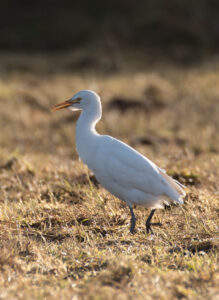
Cattle Egret – (C) Mark Underwood
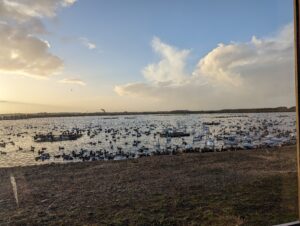
Swan Lake at Martinmere – (C) Sue Brealey
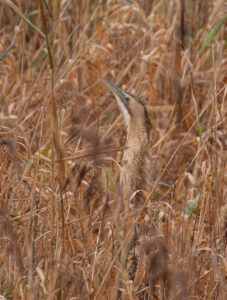
Bittern – (C) Mark Underwood
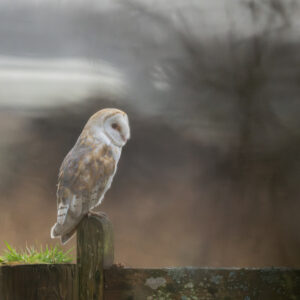
Barn Owl – (C) Jane Moore
On the Mere, Whooper Swans were prominent as well as plenty of Shelduck, Widgeon, Pintail, Mallard, Tufted Duck, Greylag Goose, Black headed Gull and Pochard. One Greylag Goose was noted the have a identification ring around its neck. On occasion plenty of Pink footed geese flew up and moved around the reserve, and large numbers of waders also flew up but in the is case due to disturbance of Marsh Harrier. After careful scanning, a couple of Snipe were seen as well as a couple of Black tailed Godwit. There was a raft of maybe up to 30 odd Coot sticking together as if they were on an island, which was an unusual site. Moorhen were noted as well. A move to the Rain’s Observatory proved a great place for lunch, and here Feral Pigeon were seen and then about 4 Ruff flew in. Jackdaw and Carrion Crow moved around, and some Teal and Cormorant were added to the list. A group of Whooper Swans swam past, and one was seen to have some sort of device around its neck. On further inspection found that part of the device had a small solar panel attached and it was realised that this was a tracking device, to be used for research purposes. A walk towards the Ron Barker Hide, added Blackbird and Woodpigeon to the list. Once at the Ron Barker hide things initially looked rather quiet. However, a pair of Mute Swan swam down the channel in from of the hide. Gradually in the distance Marsh Harrier were seen flying up and around and up to 9 of these raptors were seen prior to their roost. A Great White Egret flew into the same area. In the field to the right side, a Pheasant was seen, and then a pair of Stonechat were seen feeding from the near fence line, after which in the far corner by the entry gate a Barn Owl was seen on a post watching the area. Later it quartered the field looking for prey. As time went on, a Buzzard was seen on another post over looking the marsh area. Large flocks of Teal started to fly in as the light started to decline.
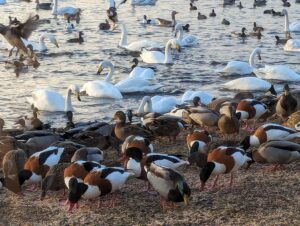
Bird Feeding – Shelduck, Whooper Swans – (C) Sue Brealey
Other members of the group walked towards the Harrier Hide, and in the hides along this track further birds were added to the list. The prime species seen was a Bittern seen from the Utilities Hide, and in the open at times, displaying behaviour usually seen in reeds, so was really interesting to note. At the Janet Kear Hide and its feeding station Great Tit, Coal Tit, Blue Tit, Chaffinch, Goldfinch, Long tailed Tit, Greenfinch were added as well as a Water Vole.
Gradually members gathered at the Discovery Hide and at 3pm the Bird Feeding started. This was enjoyed by many and afterwards everyone began to gather at the coach for the return journey, which went ahead with no problems. On the way, Great Flamingos and Eider Duck were noted in the captive area, with the Eider making their very distinguished call as people left the reserve. As requested, participants were asked to send in their sightings to ensure accuracy for the list, and so the following were added: – Canada Goose, Cattle Egret, Cettis Warbler, Collared Dove, Gadwall, Great Black backed Gull, Great Crested Grebe, Great Spotted Woodpecker, Green Sandpiper, Kestrel, Little Egret, Magpie, Red legged Partridge, Reed Bunting, Robin, Sparrowhawk, Starling and Wren. As a result, the total list of about 56 had been seen on a trip which had proved very successful and enjoyable for all.
As had been realised this was the last trip organised by the present organiser and although a programme for 2024 has been arranged, a volunteer is required as well as other posts in order for the Society to run with its usual efficiency. Any one interested do get in contact with Board members for further information.
Field Trip Meeting – Mere Sand Woods & Lunt Meadows – Sunday, 19th November 2023 – report by Sue Brealey
A group of 9 members arrived at Mere Sands Wood Reserve, near Rufford in Lancashire after a journey proving difficult due to insistent rain. The forecast was just as bleak, but on arrival, the rain had stopped, although there was a brisk wind.
The group started to walk anticlockwise around the blue route as marked on the reserve map, and saw a small bird flying into a tree which was found to be a Chaffinch. Soon the group came to the Marshall Hide, which unfortunately did not have any seats so looking out was rather awkward. The view looked out a lake which is called The Hollow. There was nothing to see so the group moved off onto the circular route which followed a path through woodland. The next hide proved to called Ainscough Hide, and this did have seats. The rain had started again but was light in nature. The group scanned the Hollow, where there were areas of trees of small long islands. Here Mallard were noted which were sheltering from the rain. A few Tufted Duck were seen and also Little Grebe. On the banks of the island a female Pintail was noted, and proved difficult to identify due to its position. A Goosander swam by. A Carrion Crow fly by, and then Moorhen were seen feeding. It was decided to move on and so the group walked round the path to the next hide. The route was very quiet with no real sign of usual woodland birds. The next hide was a small one called Redwing Hide, which overlooked the Twin Island. Here a Cormorant was seen flying over, and also some Gadwall were noted. Then the group moved to the final hide on the blue route at the Rufford Hide. Here a goodly flock of Shoveler were seen as well as Coot. Now the group walked to find the final hide which was on the part of the green route which branched off towards the end of the blue route. Here the Fletcher Hide was found overlooking the Mere End, where more Mallard and Gadwall were seen bur also Teal and Widgeon. As there were no more species were seen, the group walked back to the reception centre, where they all thankfully were able to have their lunch on the dry and warm. After lunch the group then started back to the car park to start the drive to the next venue.
After a drive of about 40 minutes, the group arrived at Lunt Meadows Reserve, near Thornton, a suburb of Liverpool. The weather had worsened, with it raining and the wind much stronger and colder due to the more open nature of the reserve. Here in worsening conditions, the group were able to see flocks of Teal, Little Egret and then at least 3 Marsh Harrier were seen flying across the reserve just from the car park. Due to the conditions, the organiser decided to return home, but the rest, being braver stayed for a further period of time when they were able to see or hear, Buzzard, Goldfinch, Meadow Pipit, Stonechat, Raven, Grey Heron, and Cetti’s Warbler. However, the hope of seeing any owls, which was the reason for the visit were dashed due to the weather. The group left just after 3pm for the journey home, after seeing about 23 species in not the best of weather.
Field Trip Meeting – RSPB Burton Mere – Sunday, 17th September 2023 – report by Sue Brealey
A group of 9 members arrived at Burton Mere, on a day which initially looked rather drab, threatening rain, but proved to be a bit cloudy, with temperatures averaging 15.7˚C.
The group started birding from the main reception area. It was mentioned that a couple of the group had seen some Pink footed Geese fly over. A good start. It was obvious that there had been some reprofiling had been carried out to the lagoon and the pond near the centre. As the group began to scan across the lagoon it was obvious that there were plenty of waders about, as well as ducks. With the ducks, there were plenty of Teal, Gadwall, Shoveler and Wigeon on the lagoon with Mallard on the pond. Canada Geese and Greylag Geese were around as well. As for waders, there were plenty of Lapwing and Black tailed Godwit. On enquiry the reserve members said their numbers of these birds going into the thousands which was good news. But amongst these birds, other species were seen in good numbers included Snipe, and right out in the open rather than sculking in vegetation, and Ruff, in all their varying colour ways as would be expected. Then at least 5 Curlew Sandpiper were seen, and then a Pectoral Sandpiper. Other birds noted included Coot, Moorhen, and Starling.
The group then decided to walk around to the Borders Hide. At the feeding station Blue Tit and Great Tit were seen and also Grey Squirrel. Along the walk, Cetti’s Warbler, Jackdaw and Chiffchaff were heard, then Migrant Hawker Dragonflies were seen, and then the group stopped at the Bridge Screen overlooking the Bridge Pool. From here plenty of Gadwall, Shoveler and Teal were seen plus a few female Pintail. Little Grebe were noted. All the duck were in eclipse plumage so really had to be studied to identify. When the group arrived at the hide, people settled in to scan across the Century & Border Pools. In the Century Pool, there was a sand bar barely covered by water but also covered with plenty of birds, especially waders. These included plenty of Lapwings and Black tailed Godwit, but as at the Reception Centre, there were plenty of other species to be added to the list. This included to a couple of Spotted Redshank going into winter plumage, a Green Sandpiper, at least 9 Golden Plover amongst the Lapwing. Amongst the Gadwall & Teal, a single very difficult to identify Garganey, as it was hunched up and asleep. One of the group saw a Red Knot, but others missed this as a Marsh Harrier flew across and after the flock settled, the Knot seemed to have gone to other areas. From the back of the hide, quite a few Cattle Egret were seen at the Border Pool, amongst some cattle and ponies. As people started to go back to the Reception Centre, a small flight of white birds was seen and these proved to be 3 Spoonbill, and these landed by the egrets.
On the way to the Centre the path has been deviated by a new Coffee Shop, which should be opening soon. Once at the centre, further scanning had Herring Gulls flying over, and amongst the waders a Little Stint and Wood Sandpiper were seen. The group then decided that they had had a really good day, and that it was time to return home. The bird lists were numbered between 33 & 40 species and people agreed they had had a lovely day.
Field Trip Meeting – Scotland – Tuesday, 30th May to Sunday, 4th June 2023 – report by Sue Brealey
This weekend bird trip which was organised as the last for the present Field Trip Organiser, and after 7 years was arranged to go to Scotland. This began with the group of 12 Society members meeting up on a travelling day on 30th May, at Aviemore, where the group were staying at the Premier Inn. Each evening, meals had been arranged at local venues, where details of the following days programme were discussed.
On Wednesday, 31st May, after breakfast and collecting sandwiches, and arranging car sharing for the whole trip, the group started off for the first stop of the Findhorn Valley. On the way, the group arrived at the Findhorn Bridge, which members remembered from previous visits, could be of value. One of the first things that occurred was the appearance of a Kestrel, near the bridge which then went and perched on a nearby telephone pole, and then going to a nearby tree, where it was presumed to have a nest (this proved erroneous). A Buzzard was noted. Looking over the bridge northwards, 3 Dippers were noted feeding along the river, and a Common Sandpiper as well as Grey Wagtail were seen. Black headed Gulls flew over the area, together with some Common Gulls and Common Tern. Amongst the smaller birds flying around included Blackbirds, House Sparrow, Chaffinch, Willow Warbler, Greenfinch, Robin, Starling and also a Mistle Thrush, Sand Martin, Swallow and House Martin flew around. Mallard, Greylag Goose were noted as well as Woodpigeon. Waders seen included Oystercatcher, Lapwing and Curlew, along with a couple of Brown Hares. Having seen as much as possible, the group started to gather to continue down to the Valley itself. However, a quick view into holes which are part of the bridge design, a nest was noted and it was concluded that this was the kestrel nest after photos were taken and the eggs identified using Google. (A return visit at the end of the break, showed that the eggs were in the process of hatching)
The group turned off to travel into the Findhorn Valley. The three cars spread out a bit and along the way the observers saw a variety of birds along the way which included Cuckoo, Chaffinch, Mistle Thrush, Pheasant, Siskin, Spotted Flycatcher and Willow Warbler. Once the group had arrived at the car park, a scan of the valley’s tops found a small group of Red Deer which moved on quite quickly. A Buzzard was seen and a bit later a Peregrine. Other birds seen while enjoying a picnic lunch, included Raven, Swallow, Pied Wagtail, Oystercatcher, and Meadow Pipit. Observing along the river, Teal, Mallard were noted along with a group of Goosander, and a Common Sandpiper. Black headed Gull and Common Gull flew around. Across the river a Feral Goat was seen, and also a Brown Hare. After deciding that there were no more species to catch the group travelled back along the Valley until turning up the road towards Farr. Along the way going through the forest and over the tops the only species seen were Chaffinch and Mistle Thrush. Once on the other side of the mountain, the group travelled to RSPB Lake Ruthven.
Once parked up and updated by the volunteer supervising the reserve, the group walked along towards the hide, but walked down to the beach area. Cuckoo and Chiffchaff were heard. On the loch Black headed Gull and Lesser Black-backed Gull flew around. On an island Common Sandpiper was noted, but swimming around were Little Grebe, Red-breasted Merganser and the species which the group had gone to the reserve to see, Slavonian Grebe. Across the loch grazing on the lower branches of trees a Roe Deer was noted. Along the walk towards the hide Wren, Long-tailed Tit, Great Tit and Chaffinch was noted. At the hide, Common Gull & Common Tern were seen flying around, and on a stone amongst the reeds were seen a group of about 8 Mallard chicks. Eventually the mother made an appearance and the chicks went to join her. It was a nice piece of behaviour to note. Reed Bunting and Slavonian Grebe were seen again and then an Osprey was seen flying in in order to feed, but it looked as if the catch was not a successful one. With having to return to the hotel, the group decided to start back after a good day’s birding and with extremely good weather.
On Thursday, 1st June after breakfast and collecting some form of picnic lunch, the group travelled up to Cairngorm Mountain. The weather was cool with low cloud with temperatures of about 4.7ºC. The group travelled up the railway arriving at the top at about 1015. At the top, the clouds were really low and despite patience watching from the viewing platform the only birds seen were Pied Wagtail and the real bonus in a Ring Ouzel when the clouds lifted briefly. After having a coffee, the group realised the clouds were going to remain low, the group went back down the mountain. From Cairngorm, the group travelled to RSPB Loch Garten initially to the Visitor Centre. On the way from the car park, Jay and Woodpigeon were noted, and at a feeding station, Siskin were seen. Within the centre there were CCTV units, which were aimed at the predictable Osprey on one of them, which was enjoyable just the same, but also a Great Tit nest with chicks, and a Goshawk, which was unexpected and enjoyable to see this bird in close quarters due to the technology.
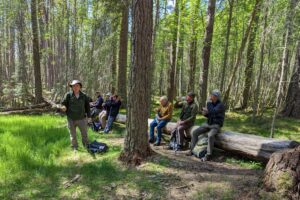
Lunch in Abernethy Forest [(c) Sue Brealey]
After this, the group travelling to Avielochan which is run by the Grantown Arms Hotel, and it was with thanks that the group were able to obtain permission to visit this small reserve. On arrival the group went to the hide and from there were able to add the following birds to the ever-increasing list of species. Carrion Crow, Common Gull, Greenfinch, Greylag Goose, Little Grebe. Mallard, Moorhen, Mute Swan, Oystercatcher, Sand Martin, Song Thrush, Swallow, Tufted Duck and the icing of the cake, Slavonian Grebe.
On Friday, 2nd June the group started the third day’s birding at Chanonry Point, on the Black Isle, overlooking the narrow strait with Fort George on the other side of the Moray Firth. The seas were at high tide, and the weather was very calm, clear and sunny, and so the chances of seeing any dolphins were on the pessimistic side. On arrival, the first bird of note seen was a Red Kite flying over. After assessing the area, the group walked along the path around the lighthouse, where Blackbird, Linnet, House Sparrow, Willow Warbler, Dunlin were noted. Common Tern, and Herring Gull flew around, and Skylark was heard, and Mistle Thrush were noted. A Guillemot waddled out of the water and rested on the beach. Cormorant flew over the area, and then a few boats were noted traveling between the strait. Then with much pleasure a couple of Bottle nosed Dolphin were seen following the boats. Gradually over the next hour several more Dolphins were noted and also a few Grey Seals. Grey Heron flew across. Returning to the car park, a group of Dunlin were noted on the beach.
At this point the group, moved to Merkinch Local Nature Reserve, which in located just north of Inverness, which consists of tidal pools, marshes, reed beds and scrubland. The group used this area as their setting for lunch. So while eating they were able to watch out for species as they came and went. There were a couple of islands which were scanned and there was a nesting area for Black headed Gull & Herring Gull. Carrion Crow and Jackdaw were noted, with Feral Pigeon flying over. With more care other birds noted include Ringed Plover, Oystercatcher, Curlew, and Dunlin. Swimming around were Mallard & Red breasted Merganser.
After this the group travelled to Culbin Forest, situated just west of Findhorn Bay. Having arrived about 3pm, it was decided to take the Gravel Pit Walk which was the shortest. Although the walk was pleasant, there were few birds around. On the walk Carrion Crow, Hooded Crow and Rook were noted, then for the small birds Chaffinch, Yellowhammer and Bullfinch were seen. As the group came to the Gravel Pit ponds, Moorhen and Little Grebe swam around. Four Spotted Chaser and Peacock Butterfly were noted as well as 2 largish nests of Wood Ants. By the pond in the shallows, there were large groups of tadpoles. Then the group travelled back to Aviemore at the end of another good day.
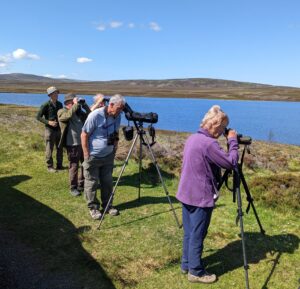
Watching family of Black-throated Divers at Lochindorb [(c) Sue Brealey)].
Having decided that there were no more species to add to the list, the group moved off towards the Black Loch area, on Dava Moor. Travelling to this spot, the group came to a large nesting area of Common Gulls. Once at Black Loch, Greylag Goose, Little Grebe, Teal and Tufted Duck were seen on the loch, and other birds noted included Blackbird, Coal Tit, Lapwing, Sand Martin, and Swallow.
The group then travelled to Loch an Eilein, near Rothiemurchus. It was hoped to have a walk, but on arrival it was found that it was really rather crowded. So as this was the last visit of the trip, it was decided that each individual could decide on what they wanted to do. Mainly the group decided to have there picnic, and then some went for a walk, while others decided to get ready for the onward journeys the following day. So while having their picnics, birds noted included Chaffinch, Long-tailed Tit, Robin, Willow Warbler and Treecreeper. On the Loch, Mallard was noted and Buzzard flew over.
On Sunday, 4th June, the group started for their onward journeys, the majority going home, some to Mull & others breaking up the journey visiting other areas of Scotland on the way. The total number of species came near to 79, although other species could have been noted and not included in the main list, plus 6 mammals and then various insects and other creatures. As a whole the trip was enjoyed by the group, who were grateful for the really good birding and also the really good weather except Cairngorm!
Field Trip Meeting – RSPB Burton Mere – Sunday, 19th March 2023 – report by Sue Brealey
A group of 8 members arrived at Burton Mere, on a day which initially looked rather drab, threatening rain, but proved to be clear, a bit windy with temperatures averaging 8˚C.
On arrival one member mentioned that they had heard and fleetingly saw a Mistle Thrush. The group started the visit in the reception centre, and this proved useful. Birds identified included lots of Black headed Gulls, Mallard, Teal, Wigeon, Canada Goose, Avocet, Lapwing, Oystercatcher, Shoveler, Tufted Duck. There were some Black tailed Godwit feeding in the shallows, but then of an island a great number of these birds were seen roosting together, up to 60+. Also, amongst them, and not seen by all group a single Ruff was noted. Then on the same island amongst the Black headed Gulls a couple of Mediterranean Gulls were seen in full summer plumage, which was welcomed by all. A group of about 35 Avocet were seen roosting together. Looking further afield, a Great White Egret was noted, and observing from a post sat a Buzzard. Also perched on some reed immediately in front of the centre was a male Stonechat, which came & went a few times.
The group then started to walk out towards the new Border Hide. At the feeding station close to the centre, Blue Tit and Great Tit were noted including a Grey Squirrel catching the seed which was dropped. It was noted that the foundations of a new café were in place, so there was some disruption of the path in the area, but not too much. A stop at the screen overlooking reed bed, there was seen a little Grebe, and a Water Rail was heard squealing in its usual manner. On the other side of the path a Cetti’s Warbler was heard quite close, and a Chiffchaff was heard making its ‘chiff’ sound but not quite getting to the ‘chaff’. The start to spring not quite there yet!! It was decided not to visit the Marsh Covet Hide, so going forward there was a stop at the Bridge Screen overlooking Bridge Pool. Just before arriving there, it was noted that there were a group of about 7 Grey Heron perched in a large tree, probably part of the Heronry noted at the reserve. On Bridge Pool, Gadwall, Carrion Crow, Coot, Moorhen were noted, plus Greylag Goose, Redshank, and Shelduck. A Stock Dove called overhead. Then on the bank on the far side of the pool, a large group of about 30 Grey Heron were seen roosting. Certainly, the largest group seen by the writer, which was really interesting.
A further walk brough the group to the Border Hide. Along the way, Dunnock, Robin, and Woodpigeon were noted. Once at the hide, the group decided it was time for a lunchbreak. Whilst having their picnic, birds seen included Black headed Gulls, Wigeon, a couple of Avocet usually feeding but occasionally mating. Another group of roosting Black tailed Godwit were seen, some of whom were well into gaining their summer plumage, and then amongst them it noted that there were a group of at least 14 Knot, an unusual sighting for the reserve. A Little Egret was seen on a bank to the right of the hide and a couple swans, thought to be Mute ones, but their heads were down so difficult to confirm. Then a Marsh Harrier was seen quartering over the reed bed, and a little later another, a female was seen perched on the top of reeds, quite near the Reception Centre. Then a male Marsh Harrier was noted flying about then dropping into the reeds, and it was concluded that these could be a pair preparing for the coming season. A Magpie and some Jackdaws were seen.
It was decided to then walk back to the Marsh Covet Hide. On the way, some of the party saw Great Crested Grebe, Great Spotted Woodpecker, Goldfinch, Blackbird, Wren, and a group of Long tailed Tits . At the hide, a birder mentioned that there were Spotted Redshank about. A search was made & a couple were seen quite close to a couple of roosting Common Redshank so comparison was not difficult, but what was nice to see was that one of them was showing signs of changing to summer plumage, in that areas of black plumage could be seen on its breast area. This was a great find for all. Also, from this hide the pair of Marsh Harrier seen earlier were noted to flying about as well.
After a quick stop at the Reception Centre, it was decided to start on the journey home, and having seen 48 species for the day, it was concluded to have been a good visit. A further visit in September should give a different sense of the reserve.
Field Trip Meeting – Parkgate and RSPB Burton Wetlands – Sunday, 26th February 2023 – report by Mim & Jock Elliot-Smith
Eleven SOS members gathered at 9.30 on a cool grey morning at Parkgate on the Wirral.
It was great to see quite a few new faces on this trip. We hope that they felt welcome and enjoyed their day.
Around an hour was spent scanning the salt marsh from the car park: Some had already spotted a Marsh Harrier on their way into the car park, and these were seen a few times while in the area. A few Little Egrets, 50-60 Teal and a number of Pink Footed Geese were immediately apparent. Further sightings included a Lesser Black Backed and a Black Headed Gull, a wren among the brown reeds, and Carrion Crow. We were treated to a fly past by 3 Curlew, and an Oystercatcher was seen and heard out on the marsh. Canada Geese, Wood Pigeon and Skylark, along with Lapwing, Magpie, Moorhen and Grey Heron were also added to the list, before the group took a short walk along the path. A skein of about 150 Pink Footed Geese flew overhead, treating us all to their evocative winter calls. In the fields behind the car park were Stock Dove, Blackbird, Redwing, Dunnock and Song Thrush. As we walked along the path, we saw Robin, Cormorant, Goldfinch and Reed Bunting – the latter out on the reeds at the edge of the marsh. Also in the reeds were Linnet, Great Black Backed Gull and Mallard. Starlings were flitting around, while a Great Spotted Woodpecker was heard drumming. Long Tailed Tits were seen high in the branches of a tree by the path, and a pair of Ravens flew over. Black Tailed Godwit, Great Tit and House Sparrow were also spotted before the group returned to the cars to move on to RSPB Burton Wetlands.
The first sighting here was of a Great White Egret in the pool right by the Visitor Centre, which also hosted some Tufted Duck, Teal and Moorhen. A few Avocet showed well in the further pool as did Shoveler and Shelduck, and Coot, Wigeon, Lapwing, Black Tailed Godwit and Redshank were spotted around the edges. We were delighted to see 28 Whooper, along with 2 Mute Swans flying onto the water, a wonderful sight! On the path away from the Visitor Centre, Blue Tit and Great Tit were seen on the feeders, with Mallard, Cormorant and Black Headed Gulls on other pools along the way. Long Tailed Tits again seen in the trees along the path, while all were pleased to hear a Cetti’s Warbler while crossing the boardwalk on their way to the Border Hide. From the screen Little Grebe and Moorhen were seen, and a Water Rail made his presence felt with his squeal. On towards the Bridge Screen, Reed Bunting and Jackdaw were seen, and at the Screen itself about 12 Pintail showed beautifully whilst a group of 7 Grey Herons lined up on the bank.
As we approached the Border Hide, a Barn Owl was fleetingly seen, disappearing up the path in front of us.
At the Border Hide, many of the species already seen were again present, however Gadwall was added to the list in the pool, and Stock Dove, Buzzard and Stonechat from just outside the hide. A Sparrowhawk was the exciting last addition to the list of 56 species for the day.
Field Trip Meeting – WWT Slimbridge – Sunday, 29th January 2023 – report by Sue Brealey
This trip was rescheduled after having to cancel the meeting in December 2022 due to extreme cold weather, which proved wise as there were several incidents which would have caused long delays. However, on this date, when all were gathered to get on the coach, the coach did not arrive. It proved that due to typo, there was an error. However, the group decided to go to Slimbridge anyway, by car, sharing as many members as possible.
The group arrived at the appointed time, and after the non-members had paid for their entry, the group dispersed around the reserve to enjoy their day. After a coffee, the writer went to the Willow hide with its feeding station and found Blackbird, Blue Tit, Great Tit, Dunnock, House Sparrow, Robin, Woodpigeon together with a couple of Grey Squirrel. It was a disappointed that Water Rail were not present, although Moorhen was seen. After this she went to the South Lake Hide, where there were several new species to be added to the list. There were plenty of Black backed Gull, a few Herring Gull and a couple of Lesser Black backed Gull. Carrion Crow, Cormorant, Greylag Goose, Shoveler, Teal, were added to the list. While enjoying some lunch, A flock of Lapwing ascended into the sky. While checking them out a Curlew was observed flying amongst them. Mute Swan was noted together with Coot, Magpie, Feral Pigeon. After some time, a short journey found the writer at the Peng Observatory where she stayed enjoying watching and learning from the behaviour of the birds on the lake. This included Berwick Swans scrambling under water in order to find some food, but showing frustration as Pochard and Tufted Duck, dived to eat these finds first. Other birds seen included, Jackdaws and Rooks. A couple of Crane flew across the lake, a lovely sight to be seen. Later on flocks of Lapwing were noted to fly up obviously as a result of being disturbed by a raptor, unseen, and then a large flock of Golden Plover rose up as well. Amongst the waterfowl were Mallard, Pintail, looking really smart, Shelduck, and a single Scaup was seen. The Observatory eventually filled up prior to the feeding time towards sunset, and this daily event was enjoyed by all.
Other members of the group spread across the rest of the reserve, and they kindly sent lists of the birds they had observed. These included the following: – Widgeon, a female Ruddy Shelduck, a dark bellied Brent Goose, amongst a few Greylag Geese, Barnacle Goose with a Ross’s Goose, White fronted Goose, both Lesser and Greenland, Snipe, Redshank, Dunlin, a Peregrine resting on a log in river sand, Collared Dove, Starling, Raven, Skylark, Meadow Pipit, Gadwall, Little Egret, Oystercatcher, Goldfinch, Pink footed Goose, Goldeneye, Eider Duck, Avocet, Black tailed Godwit, Common Gull, Grey Heron, Wren, Stonechat, Pied Wagtail, Chaffinch, Linnet, Grey Wagtail. A few of these species may have been part of the captive population, as it can be difficult to know if these are wild. As a result, amongst the group approximately 57, a really good species list.
After the feeding the group gradually collected in the car park, and prepared for the journey home, and it would seem that the group enjoyed their day.
Return to Field Trip Reports
